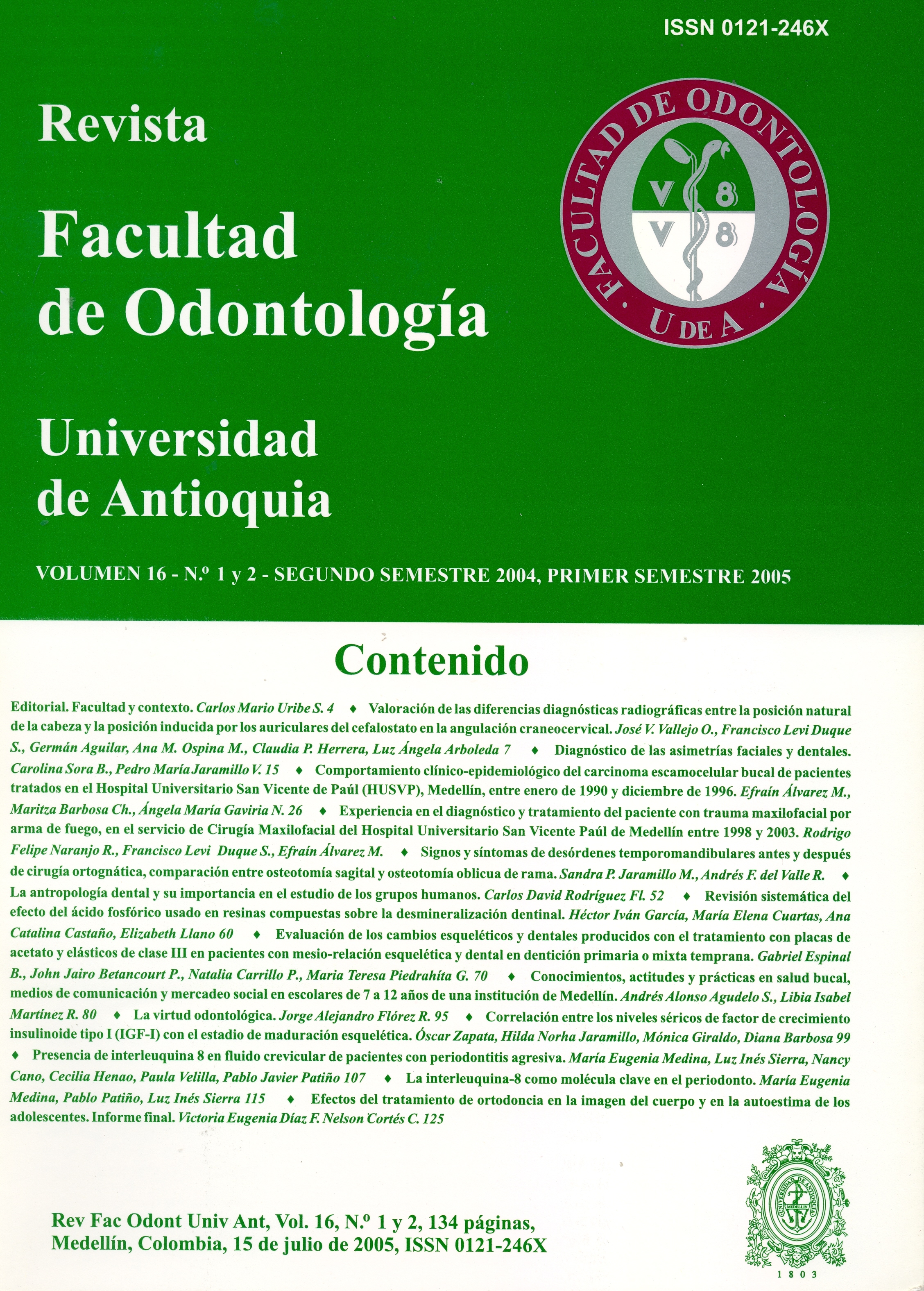Correlación entre los niveles séricos de factor de crecimiento insulinoide tipo I (IGF-I) con el estadio de maduración esquelética
DOI:
https://doi.org/10.17533/udea.rfo.3232Palabras clave:
inicio de brote puberal, desarrollo esquelético, maduración sexual, variables antropométricas, IGF-I, dimorfismo sexualResumen
Con el fin de detectar un indicador del inicio del brote puberal se correlacionaron los niveles séricos del IGF-I con la edad, el peso, la talla, el estadio de desarrollo esquelético (Hägg y Taranger) y el de la maduración sexual (Tanner y orquidiometría de Prader), se estudiaron 33 pacientes, 18 de sexo masculino y 15 de sexo femenino, entre los ocho y los once años de edad; el criterio de inclusión fue el de niños sanos con un estadio de maduración sexual de Tanner I. La toma de muestras se realizó cada seis meses durante tres años (2000-2002). La población general, mestiza, con una edad promedio de 9,48 ± 0,65 años, se ubicó en los percentiles 25-50 para peso (29,17 ± 6,41 kg) y talla (131,5 ± 6,91 cm) y en el estadio I de la maduración sexual. El 100% de la muestra tanto femenina como masculina se ubicó en el estadio F del desarrollo esquelético. No hubo diferencia, por sexo, con respecto a la concentración sérica del IGF-I (175,00 ± 77,06 en hombres y 175,80 ± 88,39 en mujeres), a pesar de lo cual en el sexo femenino se encontraron correlaciones, estadísticamente significativas, entre IGF-I y edad (r = 0,56, p = 0,031) y peso (r = 0,58, p = 0,023). Tanto en hombres como en mujeres se observaron correlaciones estadísticamente significativas entre la edad y el peso, la edad y la talla, y la talla y el peso. Los volúmenes testiculares derechos e izquierdos presentaron correlación con el peso (r = 0,60, p = 0,009; r = 0,55, p = 0,017, respectivamente) y con la talla (r = 0,53, p = 0,023; r = 0,51, p = 0,030, respectivamente). El volumen testicular derecho se correlacionó con el factor de crecimiento insulinoide (r 0,48, p = 0, 045). Finalmente, se observó correlación entre ambos volúmenes testiculares (r = 0,86, p = < 0,001). Los tamaños mamarios derecho e izquierdo presentaron correlación entre sí (r = 1,0, p = < 0,001). En conclusión, la muestra en estudio se encontró en un estadio prepuberal de maduración sexual y desarrollo esquelético y como tal se comportaron las variables de edad, peso y talla; la variable IGF-I presentó un dimorfismo sexual, en niñas este factor se comportó, comparativamente con otras poblaciones, como si estuvieran en estadio puberal.
Descargas
Descargas
Publicado
Cómo citar
Número
Sección
Licencia
El Derecho de autor comprende los derechos morales y los derechos patrimoniales.
1. Los derechos morales: nacen en el momento de la creación de la obra, sin necesidad de registro. Corresponden al autor de manera personal e irrenunciable; además, son imprescriptibles, inembargables y no negociables. Son derechos morales el derecho a la paternidad de la obra, el derecho a la integridad de la obra, el derecho a conservar la obra inédita o publicarla bajo seudónimo o anónimamente, el derecho a modificar la obra, el derecho al arrepentimiento, y el derecho a la mención, según definiciones consignadas en el artículo 40 del Estatuto de propiedad intelectual de la Universidad de Antioquia (RESOLUCIÓN RECTORAL 21231 de 2005).
2. Los derechos patrimoniales: consisten en la facultad de disponer y aprovecharse económicamente de la obra por cualquier medio. Además, las facultades patrimoniales son renunciables, embargables, prescriptibles, temporales y transmisibles, y se causan con la publicación, o con la divulgación de la obra. Para el efecto de la publicación de artículos de la Revista de la Facultad de Odontología se entiende que la Universidad de Antioquia es portadora de los derechos patrimoniales del contenido de la publicación.
Yo, el(los) autor(es), y por mi(nuestro) intermedio, la Entidad para la que estoy(estamos) trabajando, transfiero(imos) de manera definitiva, total y sin limitación alguna a la Revista Facultad de Odontología Universidad de Antioquia, los derechos patrimoniales que le corresponden sobre el artículo presentado para ser publicado tanto física como digitalmente. Declaro(amos) además que este artículo ni parte de él ha sido publicado en otra revista.
Política de Acceso Abierto
Esta revista provee acceso libre inmediato a su contenido, bajo el principio de que poner la investigación a disposición del público de manera gratuita contribuye a un mayor intercambio de conocimiento global.
Licencia Creative Commons
La Revista facilita sus contenidos a terceros sin mediar para ello ningún tipo de contraprestación económica o embargo sobre los artículos. Para ello adopta el modelo de contrato de licenciamiento de la organización Creative Commons denominada Atribución – No comercial – Compartir igual (BY-NC-SA). Esta licencia les permite a otras partes distribuir, remezclar, retocar y crear a partir de la obra de modo no comercial, siempre y cuando nos den crédito y licencien sus nuevas creaciones bajo las mismas condiciones.
Esta obra está bajo una Licencia Creative Commons Atribución-NoComercial-CompartirIgual 4.0 Internacional.














